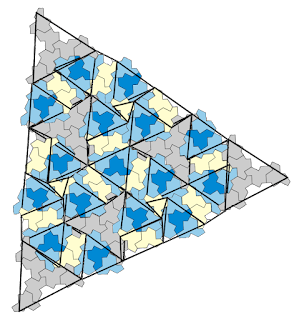This is the third post in a series that began with my post on Fibonacci Bands in Aperiodic Patterns. The second post in the series focused on patterns created by joining Fibonacci triangles at their vertices. In this post, we'll look at related aperiodic patterns created by joining Fibonacci triangles at their edges. As before, we start with an equilateral triangle whose side lengths correspond to a Fibonacci number. In this case, I've started with a 13-triangle.
Next, I surround each 8-triangle with 3- and 5-triangles, in the same manner as before (left image). Then I surround each 5- with 2- and 3-triangles (right image).
Next, I surrounded each 3-triangle with 2-triangles. I omitted the 1-triangles, which I think just add too much clutter.
I've colored this image to highlight Fibonacci bands, with the big dark blue triangles corresponding to 0-bands, and the small yellow and green triangles corresponding to 1-bands. Thus, reading from top to bottom, these bands form the Fibonacci word 1011010110110101101.
Here's the same pattern again, this time starting from an 8-triangle (and using the isometric dot grid differently to allow for more detail later).
Consider each of the 1-triangles that I omitted when surrounding the 3-triangles. I connect the vertices of each of those 1-triangles to the centers of those triangles, forming the bold Y shapes in the image below.
Going clockwise around each 2-triangle, I leave the first half of each side alone, and add a Y shape to the I second half of each side (left image). The result is remarkably similar to an image we saw in the previous post, when we joined Fibonacci triangles at their vertices (right image). Personally, I find the left image more pleasing. And it reminds me of brain tissue.
Adding lines to the 2-triangles and parallelograms gives us the following--an unmistakeable chevron tiling matching those introduced in the paper An Aperiodic Monotile. The shapes outlined in bold correspond precisely to the chevron version of the metatiles from that paper.
And this gives us a new way to think about the chevron tiling. It's simply formed by joining decorated Fibonacci triangles, in the manner described above. These triangles are easily seen in the image below.
In An Aperiodic Monotile, the authors show that there is a one-to-one correspondence between chevrons and "hat" tiles. The images below show a chevron broken into 3 L's, which form a "hat" tile (that we humbly believe looks more like a T-shirt than a hat).
Unfortunately, we can't simply draw hats into the Fibonacci triangle pattern, but we can come close. The images that follow show the correspondence between chevron Fibonacci triangles and hat triangles (and parallelograms).
And, finally, here's a distorted Fibonacci triangle pattern that emerges from using this set of triangles/parallelograms.




















No comments:
Post a Comment